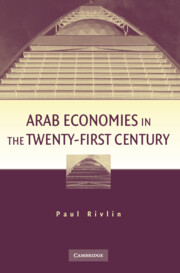2 - Demography and Economics
Published online by Cambridge University Press: 05 June 2012
Summary
During the last twenty-five years, all of the countries examined in this book have experienced significant declines in their demographic growth rates. This is mainly the result of a fall in fertility rates that started in North Africa and later spread to the rest of the Middle East. Despite the demographic slowdown, the rates of growth in most of the countries remain high by international standards and the absolute increases of the population in all of them are large. In 2000–05, the population of eighteen Arab states rose by more than six million a year or about 2.2 percent annually (see Table 2.1). One of the consequences of demographic change has been the creation of a large young population of reproductive age. Another is a rapidly growing labor force. None of this is expected to change in the next twenty years. Although the population of working age has grown, so has the size of the dependent population and as a result the pressure for public sector spending on social services such as education, health, and welfare has increased, often beyond the financial abilities of governments. In the non-oil states and those with small oil incomes, taxation was the main source of funding for government spending and was usually under pressure. This was particularly true during periods of recession and when stabilization programs were being introduced. In the oil-rich states, the problems were much less acute, but they have occurred during periods of low oil revenues.
- Type
- Chapter
- Information
- Arab Economies in the Twenty-First Century , pp. 7 - 35Publisher: Cambridge University PressPrint publication year: 2009

